- Home
- entertainment
- news
- The 23 best scenes in 'Heartstopper' that perfectly match the original comic
The 23 best scenes in 'Heartstopper' that perfectly match the original comic
Kim Renfro

- Netflix's "Heartstopper" TV show is based on an original comic by Alice Oseman.
- Though Oseman changed and expanded the story for the TV adaptation, many scenes stayed the same.
Director Euros Lyn began the show with a perfect adaptation of the moment Nick and Charlie first met each other.
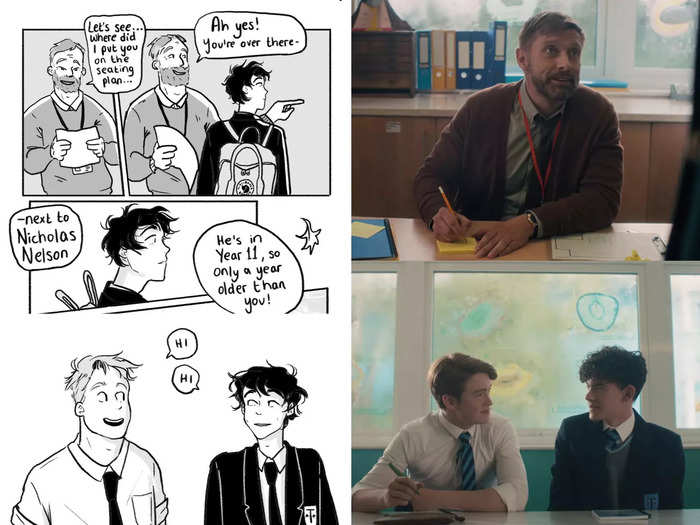
The actor cast as the teacher even has the same facial hair and outfit that Oseman drew in the comic.
Kit Connor plays Nick Nelson, the "rugby star" of a UK high school. Joe Locke plays the main protagonist, Charlie Spring, the only openly gay teenager at an all-boys school.
When Nick and Charlie are assigned seats next to each other in class, they begin an unlikely friendship that soon turns into something much more. But as the two boys try to sort out their romantic lives, they have to contend with a group of bullies that include Charlie's ex-hookup Ben and Nick's friend Harry.
The show includes animated lighting and details like leaves that come straight from Oseman's comic, as you can see below.

Nick and Charlie become friends in the show just as they do in the comic — through chatting in their class and eventually playing rugby together.
In the scene shown here, Nick approaches Charlie to ask if he'll join the rugby team. Charlie daydreams for a moment, imagining Nick confessing his love for Charlie and saying he's gay too.
The dialogue is taken right from Oseman's original comic, including Charlie teasing Nick about calling him "weak."
Another scene that is taken verbatim from the comics is the incident when Charlie's awful encounter with Ben is interrupted by Nick.
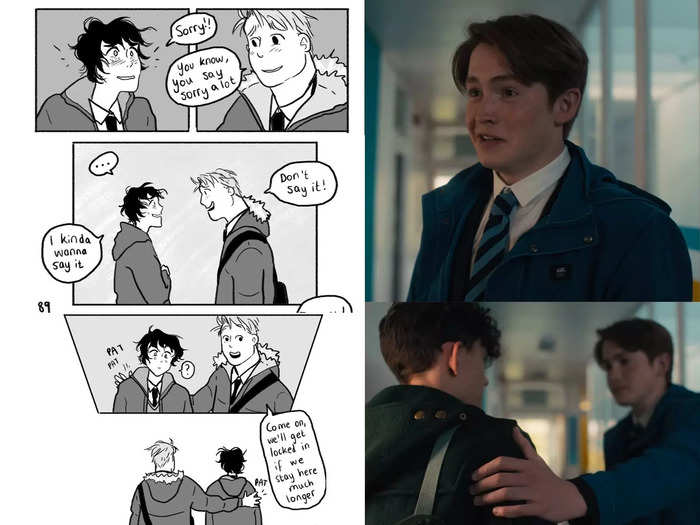
The set-up for the season includes a backstory about Ben, a boy who seeks out Charlie for makeout sessions but then acts cruelly towards him in public.
The secret meetings come to a head when Charlie decides he's had enough of this treatment and tries to break things off with Ben, only to have the older boy push him against the wall and kiss him against his will. Nick arrives to the scene, and pulls Ben off of Charlie.
This is one of the first times we see Nick go out of his way to make sure Charlie is OK — and it's the first time Charlie gets the feeling that maybe Nick could have feelings for him in return.
Nick gives Charlie a few pats on the arm instead of hugging him in this moment, but it's the scene that cements their close friendship (which serves as the foundation for their future romantic relationship).
Other details included in the show, like the seagulls that accompany Nick's romantic feelings for Charlie, were also pulled from the comics.
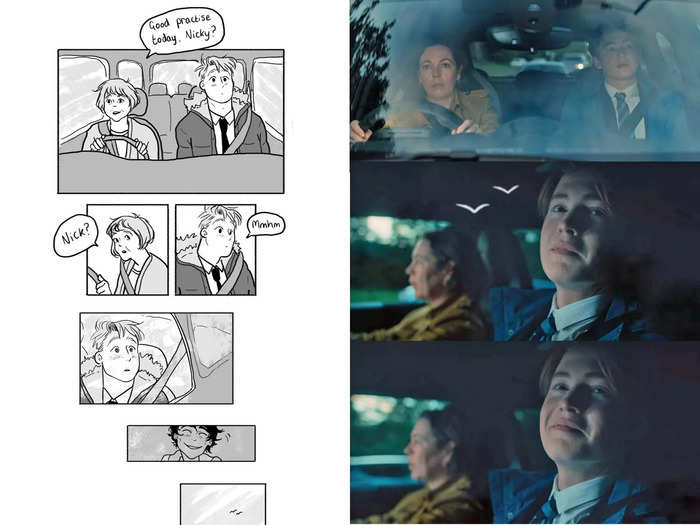
In this scene, Nick smiles while thinking about Charlie and looking out of the car window. The camera angles very closely match the exact panels of this moment in the comics.
In Oseman's original drawings, they actually included a little flashback panel of Charlie's face as Nick thinks about his new friend.
There are also tons of details in the production design for Nick and Charlie's bedrooms that perfectly mirror the comics.

From the Daft Punk and Strokes posters above Charlie's drum set to the beams in Nick's ceiling and his string lights, the "Heartstopper" crew went above and beyond to bring the drawings of the boys' bedrooms to life for the show.
All of the text conversations between Nick and Charlie were similarly pulled right from Oseman's original writing.
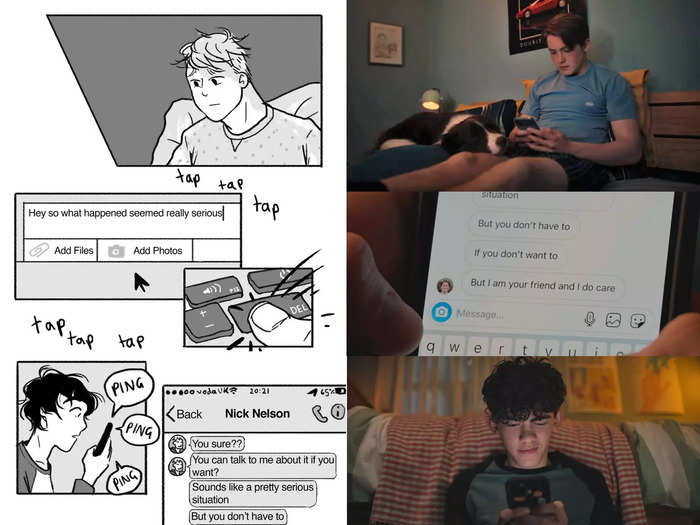
This sweet scene is another key moment in Nick and Charlie's friendship. While Charlie would rather brush the incident with Ben under the rug, Nick is persistent and careful to make sure his new friend feels supported.
Charlie goes with his gut and opens up to Nick about the horrible treatment he'd received from Ben and other bullies at their school.
Their text exchanges were word-for-word placed into the show's version of events.
The first time Nick and Charlie spend time together outside of school was also a sweet montage straight from the comics.
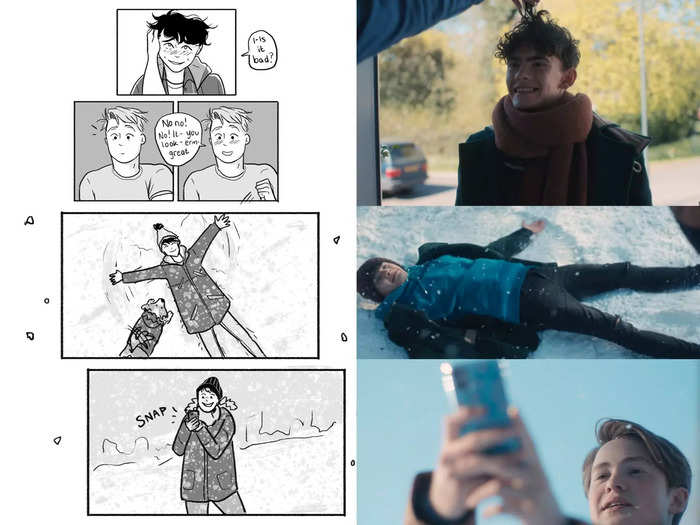
Every detail like Nick noticing Charlie's new haircut, their Mario Kart challenge, and snowball fight was featured in Oseman's original story.
The snow-day montage leads right into another pivotal scene: Nick's mom pointing out that he seems much more "like himself" when he's with Charlie.

Oseman builds up Nick's character carefully with scenes like this one, letting the reader (or viewer) know that the happiness Nick finds in Charlie's company is genuine.
As the story continues, Nick starts realizing that his friend group at school (mostly jocks and bullies) aren't truly his friends.
The show even brought to life the mug of tea that Nick is usually drinking whenever he chats with his mom in the kitchen.
The scene where Nick thinks about holding Charlie's hand exactly mirrors the panels in Oseman's comic.
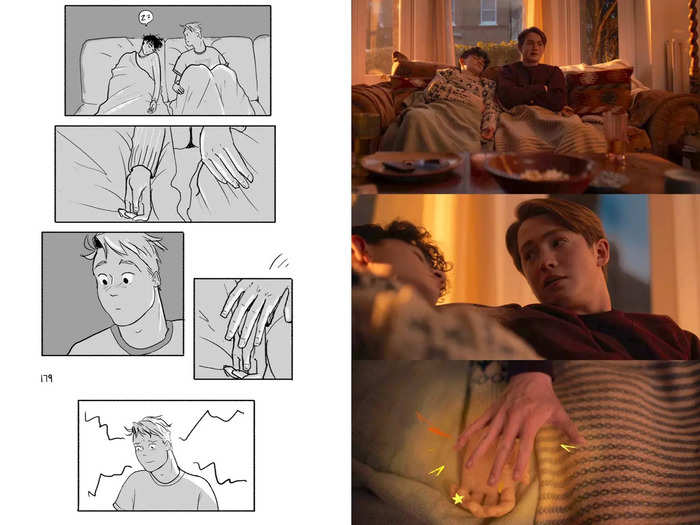
Once again, little details of Oseman's comics were brought to the screen.
The little zaps of lightning and sparks that Nick feels when he puts his hand near Charlie's were included in the original drawings. (That little zig-zag motion is used whenever Nick starts having feelings of attraction for his new friend.)
One of the most heartbreaking scenes in the show comes when Nick decides to try and figure out what his feelings for Charlie mean.
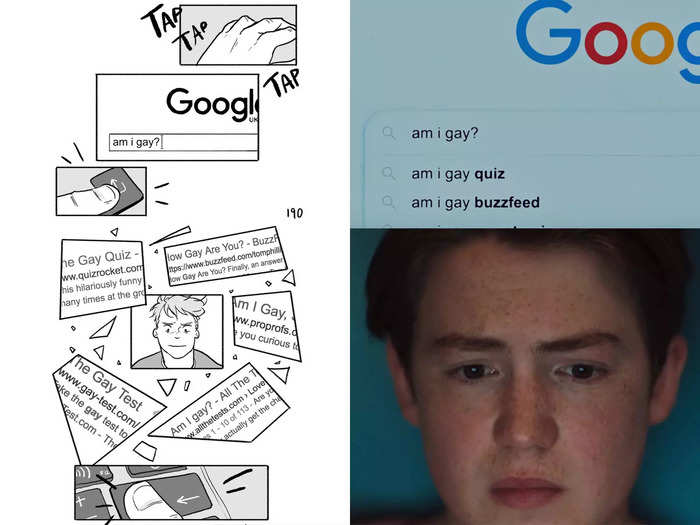
After giving Charlie a long hug for the first time, Nick goes home and decides to do some internet investigating about what his feelings might mean.
He nervously types "Am I gay?" into a Google search bar — yet another verbatim moment pulled from Oseman's original comic.
As Nick is inundated with "gay quizzes" and news stories about discrimination and homophobia, he gets increasingly distressed and lets out a single tear.
During Harry's birthday party scene, actor Kit Connor recreated the exact arm gestures from the comic.
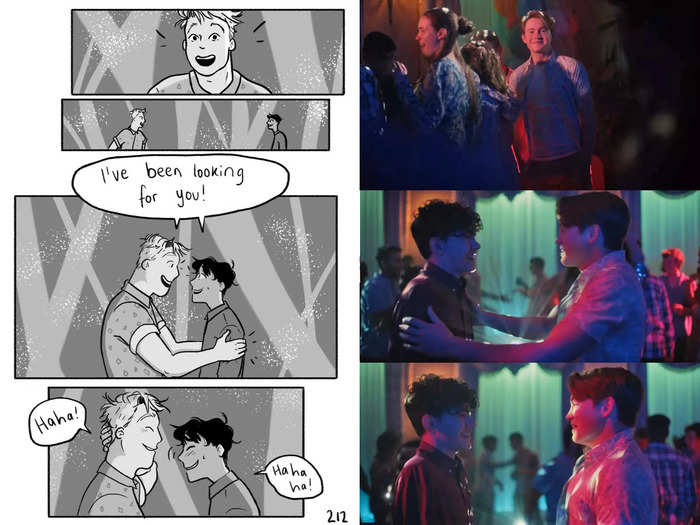
The next episode includes a much more joyous scene where Nick excitedly greets Charlie at a birthday party.
The original comic is in black and white, but for the live-action show, the producers requested that Nick be bathed in "bisexual lighting," or lighting that's blue, pink, and purple — colors of the bisexual pride flag.
Though Nick hasn't realized he's bisexual at this point, the lighting helped clue the audience into his journey of self-discovery.
Most of the party scene is exactly the same as the comics, including Nick and Charlie's race upstairs and their first kiss.
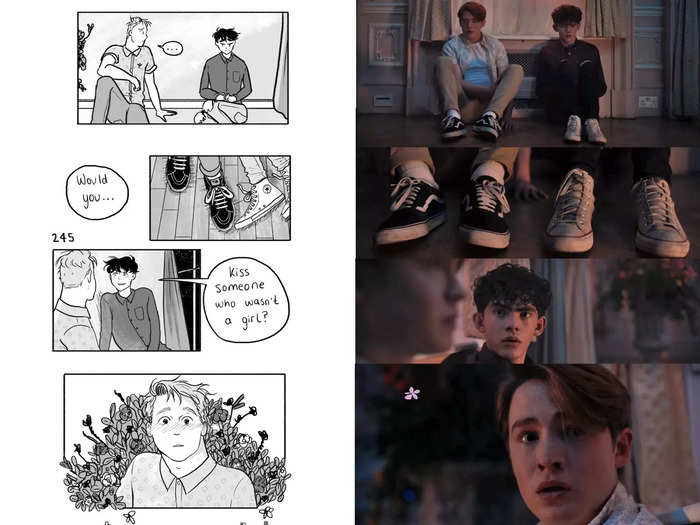
Once again, director Euros Lyn worked with Oseman's script to recreate this scene with incredibly specific details.
A recurring motif you see throughout the show and comics is Nick and Charlie's shoes. Nick's black and white Vans and Charlie's white Converse were part of their character design in Oseman's story.
Charlie's anxiety over his kiss with Nick is likewise mimicked perfectly in the show, down to the detail of the time on his phone reading exactly 10:34.
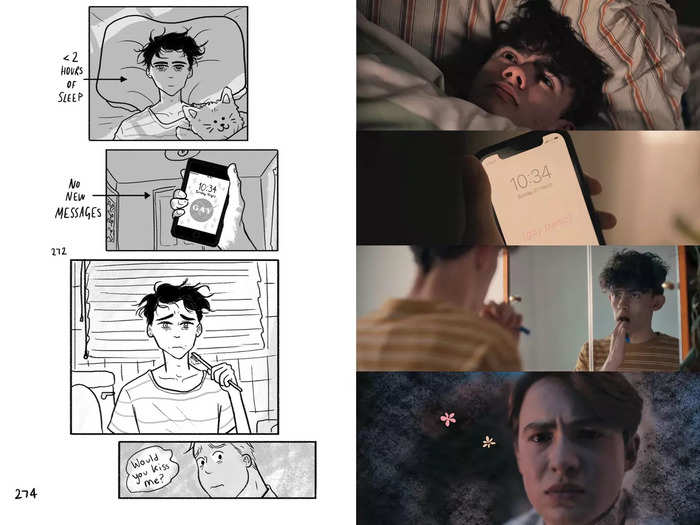
Nick ran away from Charlie after their kiss, choosing to go deal with the school bully, Harry, instead of risking getting caught alone with Nick.
So while Charlie is reflecting on the kiss the next morning, he convinces himself that Nick didn't really want to do it and now their friendship is ruined.
The only thing that changed about this scene for the Netflix show is a different background on Charlie's phone. The comics have a NASA logo that says "GAY" instead of NASA. But in the show, Charlie's phone says "gay panic" instead.
But the episode (and comic) end with a hopeful cliffhanger as Nick shows up at Charlie's front door.

Oseman wrote this rom-com-worthy moment into both the comic and show, letting the audience once again see Nick's persistence in trying to right any wrongs in his relationship with Charlie.
The following episode continues the scene, showing Nick and Charlie sharing their second, and much more confident, kiss.
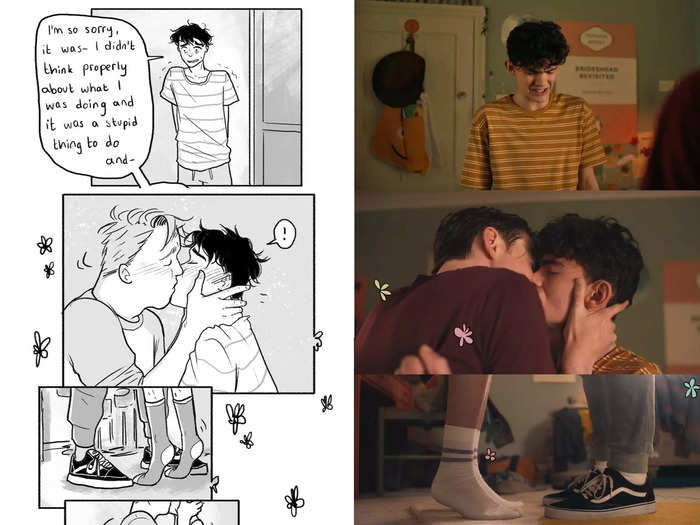
From Charlie's nervous habit of looking down while talking to the exact way Nick holds Charlie's head during their kiss, this scene once again featured body language and scene framing that looks exactly like Oseman's drawings.
The show also included the little swirling flowers that symbolize Nick and Charlie's affection for each other.
Plus we get another little foot moment with Nick's Vans and Charlie's socked feet raising up on his toes during their kiss.
After Nick and Charlie begin secretly dating, they share a sweet scene at an arcade.

Nick comes to a bowling alley and arcade to meet some of Charlie's friends and celebrate his birthday, bringing along a present.
The Netflix show perfectly recreated the homemade photo frame and a selfie taken of Charlie, Nick, and Nick's sweet little dog Nellie.
In both the show and the comics, Nick tells Charlie that their snow day was one of his "favorite days ever."
Another sweet scene brought to life from the comics is the moment when Nick calls Charlie "Char" for the first time.
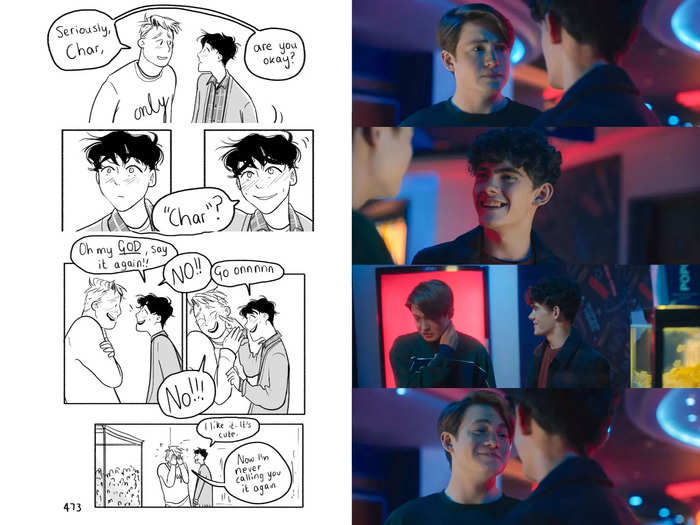
Nick and Charlie go to the movies with some friends, and to both their dismay Ben and Harry (Charlie's bullies) are there. When Nick checks in on how Charlie is feeling, he calls him "Char."
Charlie is totally delighted to hear this nickname, and promptly makes Nick blush and turn bashful.
The dialogue, including Nick saying "now I'm never calling you it again," is all straight from Oseman's original story.
Inside the theater, the show once again framed some of the scenes in an exact copy from Oseman's drawings.
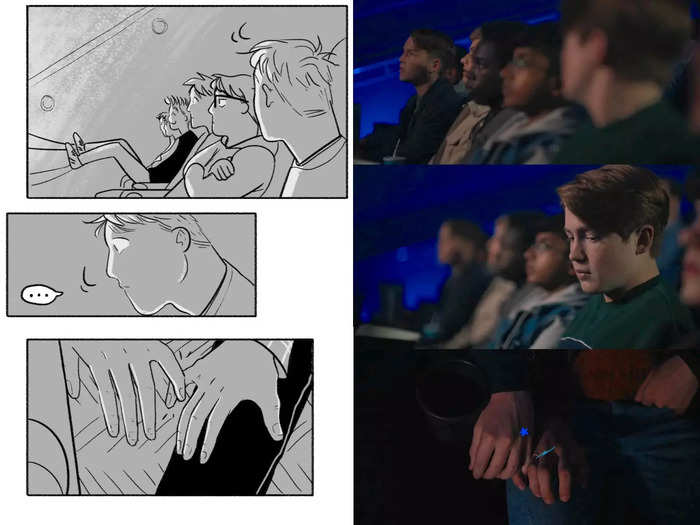
For this scene, it looks like Oseman's comics were basically the storyboard for the live-action show. Everything from Nick's glance over towards Harry to the way his pinky reaches out for Charlie's is right out of the original "Heartstopper" comic page.
Nick's breaking point with his "friends" comes when Harry bullies Charlie worse than ever.
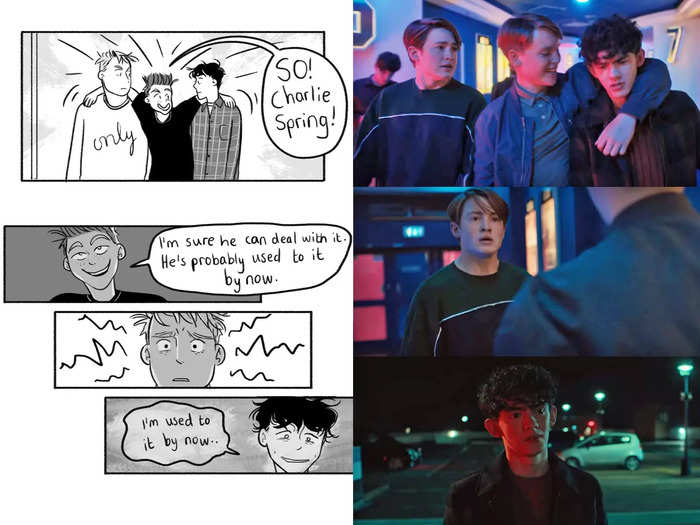
Harry picks on Charlie once again, prompting Nick to call him out for being homophobic. Charlie leaves, privately telling Nick that he's used to it by now.
But when Nick returns to the bully to confront him, Harry just echoes Charlie's words, saying "he's probably used to it by now."
The comic makes it clear that Nick registers the truth of this, which only makes him angrier with Harry. After Harry uses the f-slur, Nick snaps and punches him in the face, no longer able to tolerate the homophobia.
In the season finale, Nick and Charlie's first solo date includes a bonus cameo from Oseman.
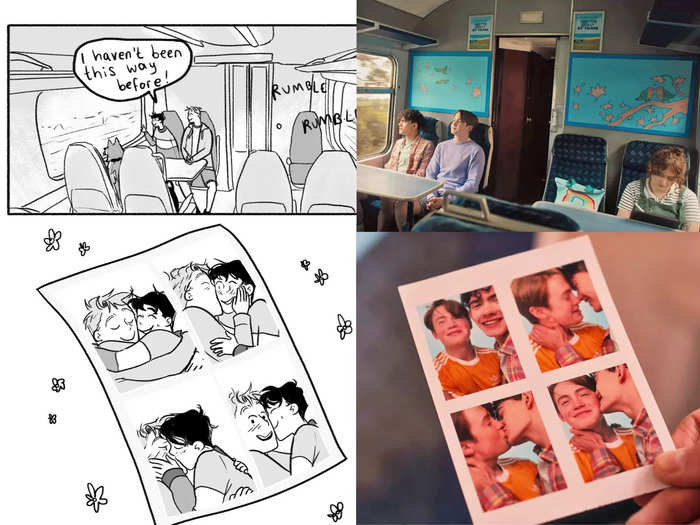
Most of the scenes of their beach trip are taken right out of Oseman's comic. The only meaningful change is in the train ride there: You can see Oseman sitting in the seat across the aisle from Nick and Charlie in the Netflix scene.
A fan-favorite scene in "Heartstopper" is of course the photo booth, where Nick and Charlie both grin goofily and kiss for the camera.
The beach scene where Nick declares himself and Charlie as "boyfriends" was recreated perfectly, down to the detail of Nick walking into the ocean in his shoes and socks.
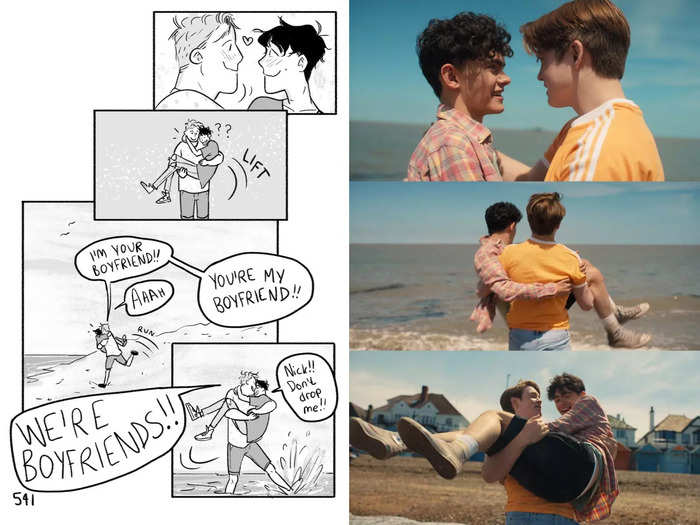
Yes, in the original story Nick also walks right into the ocean while still wearing his shoes and socks. But he's so smitten with his now-official boyfriend that he doesn't seem to care.
"Heartstoppers" ends with Nick coming out to his mom as bisexual with dialogue taken right from the comic.
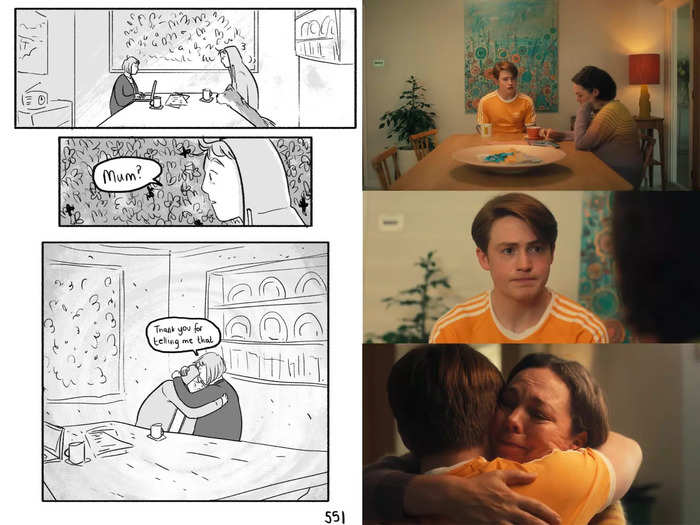
Oseman didn't make many changes to this scene although it was pared down to the simplest dialogue from the comic.
Both versions include the important line when Nick's mom thanks him for telling her, and says, "I'm sorry if I ever made you feel like you couldn't tell me that."
Nick's anxiety at the moment and his mom's warm embrace were all perfectly brought to life for this emotional conclusion to season one.
Though the show ends there (for now), Oseman has already published many more chapters in the "Heartstopper" comic that might serve as the basis for future seasons of the Netflix show.
Slide Embed
Note: For the purposes of this article, we have edited together different panels of Oseman's original comic, so some moments you'll see are out of order. To view the original comic in its entirety, visit Oseman's website here.
READ MORE ARTICLES ON
Popular Right Now
Popular Keywords
Advertisement